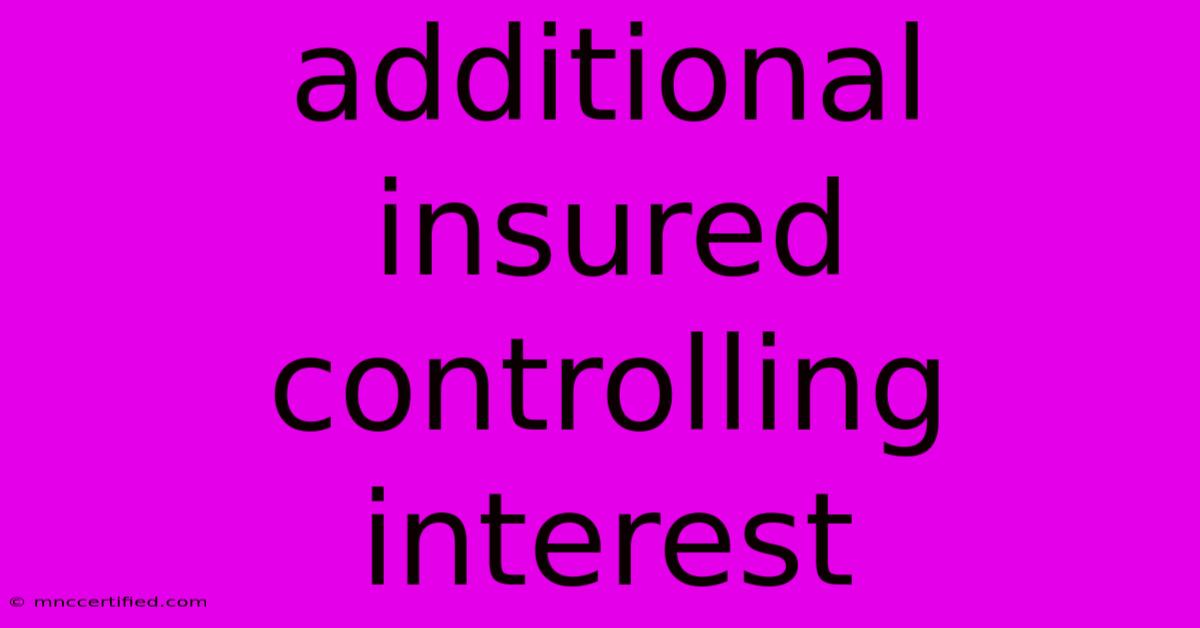Additional Insured Controlling Interest

Table of Contents
Understanding Additional Insured Status and Controlling Interest: A Comprehensive Guide
In the complex world of insurance, understanding the nuances of "additional insured" status and its relationship with "controlling interest" is crucial for businesses and individuals alike. This guide will break down these concepts, explaining their significance and implications for liability protection.
What is an Additional Insured?
An additional insured is a party who is added to an insurance policy beyond the named insured. This addition extends coverage to the additional insured, meaning they are protected in the event of a covered loss or incident.
Why is this important? Adding someone as an additional insured provides an extra layer of protection, particularly in situations where:
- Liability risks are shared: If two parties are involved in a project and one party could be held liable for the actions of the other, adding the second party as an additional insured on the first party's policy can offer peace of mind.
- Contractual requirements: Many contracts, especially in construction and commercial agreements, specifically require that one party be named as an additional insured on the other party's policy.
- Protecting financial interests: Adding a party as an additional insured can help safeguard financial assets and prevent legal disputes.
The Role of Controlling Interest
Controlling interest refers to the ownership or control of a company. This can involve holding a majority of the shares or having the power to make significant decisions about the company's operations.
How does it relate to additional insured status?
When an entity with controlling interest in a company is added as an additional insured on the company's insurance policy, it can significantly impact liability coverage.
Here's why:
- Liability protection for the controlling entity: By being listed as an additional insured, the controlling entity gains protection against claims arising from the company's operations, even if they weren't directly involved in the incident.
- Potential for broader coverage: The scope of coverage for the controlling entity may extend beyond the company's operations and encompass activities related to their ownership or control.
Key Considerations and Examples
Several factors come into play when determining whether to add a controlling entity as an additional insured:
- Nature of the business: The type of industry and risks associated with the company's operations can influence the need for additional insured status.
- Contractual obligations: Contractual agreements often specify whether a controlling entity should be named as an additional insured.
- Specific terms of the insurance policy: The insurance policy must clearly define the extent of coverage for the additional insured, including any limitations or exclusions.
Example:
Imagine a construction project where a general contractor (Company A) hires a subcontractor (Company B). Company A has a controlling interest in Company B. The general contractor's insurance policy might list Company B as an additional insured to protect both entities from liability arising from the project.
Understanding the Implications
Adding a controlling entity as an additional insured can:
- Reduce the risk of financial losses: It provides a buffer against potential lawsuits or claims related to the company's operations.
- Strengthen relationships: It demonstrates a commitment to protecting all parties involved in a project or agreement.
- Complicate insurance coverage: Adding an additional insured can affect premiums and increase the complexity of policy terms.
Conclusion
Understanding the concepts of additional insured status and controlling interest is vital for businesses and individuals involved in various commercial activities. Consulting with an insurance professional is essential to ensure proper policy coverage and minimize liability risks. This can help businesses navigate complex situations and protect their financial interests while fostering trust and collaboration.

Thank you for visiting our website wich cover about Additional Insured Controlling Interest. We hope the information provided has been useful to you. Feel free to contact us if you have any questions or need further assistance. See you next time and dont miss to bookmark.
Featured Posts
-
Ravens Vs Bengals Predictions And Live Scores
Nov 08, 2024
-
Health Insurance Paid Time Off Crossword
Nov 08, 2024
-
Israeli Fans Ambushed In Amsterdam Soccer Violence
Nov 08, 2024
-
Does Liability Insurance Cover Car Theft
Nov 08, 2024
-
Crypto Loko No Deposit Bonus Codes 2023
Nov 08, 2024